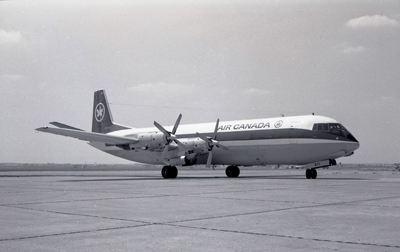
Features
Operations
A Look Back: THE VICKERS VANGUARD
How often can you think of a successful military or commercial aircraft, followed by another aircraft produced by the same company, that failed to come close to the fame enjoyed by its predecessor?
April 15, 2010 By Raymond Canon
How often can you think of a successful military or commercial aircraft, followed by another aircraft produced by the same company, that failed to come close to the fame enjoyed by its predecessor? There was the Supermarine Spitfire followed eventually by the Swift, something of a disaster except for low-level photo-reconnaissance work. In Germany, the Me-110 had far more success than did either of its successors, the Me-210 and -410. In the United States the F-80 could not come close to competing with the Mig-15 but achieved fame when converted to the T-33 training aircraft. Finally, there was the Lockheed Electra, which did not come close to the fame enjoyed by the Constellation, one of the most elegant aircraft ever produced.
 |
The Vickers Vanguard falls into a similar category. Built by the same company as the Viscount (a noticeable winner as a four-engined turbo-prop short-range passenger aircraft), the Vanguard never came close to its predecessor and your humble scribe, who has flown in both of them and liked them both, thinks he know why.
The Vanguard first appeared in 1959. This was well after the short-lived but epoch-making Avro Canada Jetliner from the same stable as the CF-100 and the Arrow. When the Vanguard took to the air, it was considered to be a turbo-prop contemporary of the DC-8 and the Boeing 707. There was nothing fundamentally wrong with the aircraft; it had several nice characteristics. The mistake, and it was a big one, was in the minds of the Vickers management who thought up the idea of producing a big brother to the Viscount in the face of the incipient jet onslaught.
Canadians, if they remember the aircraft at all, do so because TCA (Trans-Canada Airlines – later Air Canada during the aircraft's years of service) was, after Britian’s BEA, the only other buyer, taking 23 of the 952 version which had a more powerful engine (Rolls-Royce Tyne) than the British European Airways (BEA) model. The Vanguard had twice the service ceiling of the Viscount and, at a top speed of 425 miles per hour, was one of the fastest turboprops ever. Had it come under different situations, it might have been as popular as the Viscount.
The aircraft offered capacity in the vicinity of 130 seats. Many flew with just one class – economy – but others had a small number of first-class seats. It was economical to operate and on short trips such as London-Paris or Toronto-Montreal/Ottawa, it could compete with jet rivals in cost and time. However, the arrival of commercial jets hastened its demise.
It was actually Air Canada that pointed the way to the Vanguard’s alternative role. In 1966, one aircraft, C-FTKK, was taken from the airline’s passenger service, all seats were stripped from it and it became employed in the cargo-only role. Three years later, BEA did the same thing, operating no fewer than nine aircraft as “Merchantmen,” in which role they operated for a further 10 years.
In this fashion, the aircraft was able to extend its rather short life in as far away places as Indonesia. A number of smaller cargo companies subsequently bought up available Vanguards from the two airlines and used them for freight. Others were employed as charter passenger aircraft. There were several crashes, the most serious one being at Basel Airport in Switzerland in 1974, killing the four crew and more than 100 passengers. Another tried to take off at Toulouse with three engines and didn’t make it.
The last Vanguard, which flew under British registry, was retired in 1993. Sadly, no example of the aircraft remains in Canada, although there is one Viscount at the Canada Aviation Museum in Ottawa.
| Quick facts… about the Vickers Vanguard
Role: Airline Manufacturer: Vickers-Armstrong First flight: Jan. 20, 1959 Introduced: 1961 Retired: 1993 Primary users: British European Airways, Trans-Canada Airlines Number Built: 43 Maximum speed: 684 km/h (425 mph) Range: 2,945 km (1,830 miles) Capacity: 139 passengers Crew: 2-3 Wingspan: 36.1 M (118 ft. 7 in.) Length: 37.45 m (122 ft. 10 in.) Height: 10.64 m (34 ft. 11 in.) Service Ceiling: 30,000 ft. |